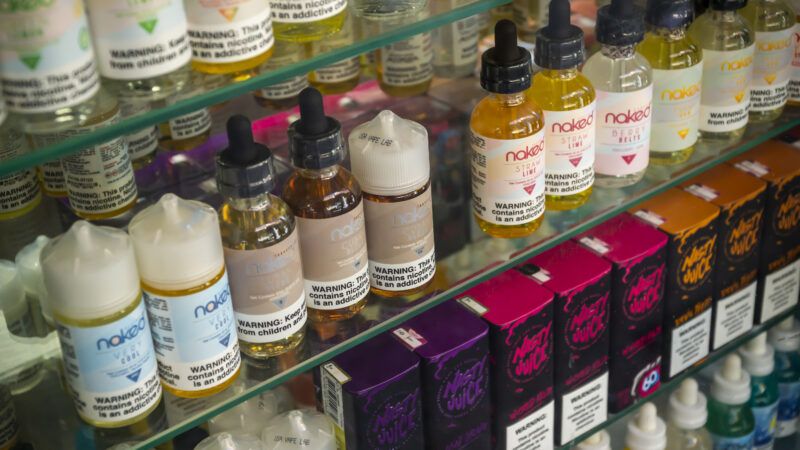Remember the Teen Vaping 'Epidemic'?
Policies inspired by that exaggerated threat continue to undermine the harm-reducing potential of e-cigarettes.

Remember the "epidemic" of underage nicotine vaping? For years, activists, politicians, and public health officials have been warning that a surge in e-cigarette use by teenagers would hook a generation of young people on nicotine and encourage them to smoke.
That never happened, as new federal survey data confirm. But policies adopted in response to that overblown threat continue to undermine the harm-reducing potential of vaping products by making them less attractive to current and former smokers.
According to the latest National Youth Tobacco Survey, which is overseen by the Centers for Disease Control and Prevention (CDC), 10 percent of high school students reported past-month e-cigarette use in 2023, down from 14 percent last year and more than 27 percent in 2019. Among middle school students, the 2023 rate was 4.6 percent, less than half the 2019 rate.
How many of those past-month vapers might reasonably be described as addicted to nicotine? A quarter of them—less than 2 percent of all respondents—reported vaping every day in the previous month, meaning that, as usual, the vast majority were occasional users.
This does not look like an epidemic of nicotine addiction. Nor did the fear that vaping would lead to smoking pan out.
Even at the peak of underage vaping, the downward trend in adolescent smoking not only continued but accelerated. In the 2023 survey, less than 2 percent of high school students reported smoking cigarettes in the previous month—down from 16 percent in 2011 and (according to a survey of 10th- and 12th-graders) more than 30 percent in 1997.
The CDC describes vaping as "tobacco product use," even though e-cigarettes do not contain tobacco, and lumps it in with smoking, even though it does not involve combustion. But while the CDC is loath to admit it, the shift from smoking to vaping—in any age group—is indisputably an improvement in terms of health risks.
The Food and Drug Administration (FDA) acknowledges that vaping is far less hazardous than smoking, and it supposedly is committed to maintaining the availability of what it calls "electronic nicotine delivery systems" (ENDS) as a potentially lifesaving alternative for cigarette smokers. Yet to deter underage use, the FDA so far has approved only tobacco-flavored ENDS, even though former smokers overwhelmingly prefer other flavors.
That policy makes ENDS less appealing to people who already have switched from smoking to vaping or might be interested in doing so. The results are predictable: A recent FDA-supported study of sales data from across the country found that state and local restrictions on ENDS flavors were associated with increased purchases of conventional cigarettes.
"We find that ENDS flavor policies reduce flavored ENDS sales as intended, but also increase cigarette sales across age groups," the researchers reported. "As cigarettes are much more lethal than ENDS, the high rate of substitution estimated here suggests that, on net, any population health benefits of ENDS flavor policies are likely small or even negative."
Although "flavored ENDS products remain widely available in states that do not prohibit their sales," the study's authors noted, the FDA seems to be "paving a path towards a de facto national ENDS flavor prohibition." That policy, they said, entails an "inequitable tradeoff" because it "prioritizes youth over the 11.2% of US adults [who] smoke."
Since the FDA has not made a serious effort to enforce its de facto ban against the thousands of suppliers who are theoretically violating it, adults can still purchase ENDS in a wide variety of flavors from vape shops, tobacconists, and online vendors. Preserving those options for adults is consistent with efforts to reduce underage consumption, as the ongoing decline in adolescent vaping shows.
The flavor restrictions embraced by regulators and legislators threaten to harm public health in the name of protecting it. To save teenagers from an exaggerated danger, bureaucrats and politicians are sacrificing the interests, and perhaps the lives, of adult smokers across the country.
© Copyright 2023 by Creators Syndicate Inc.



Show Comments (13)